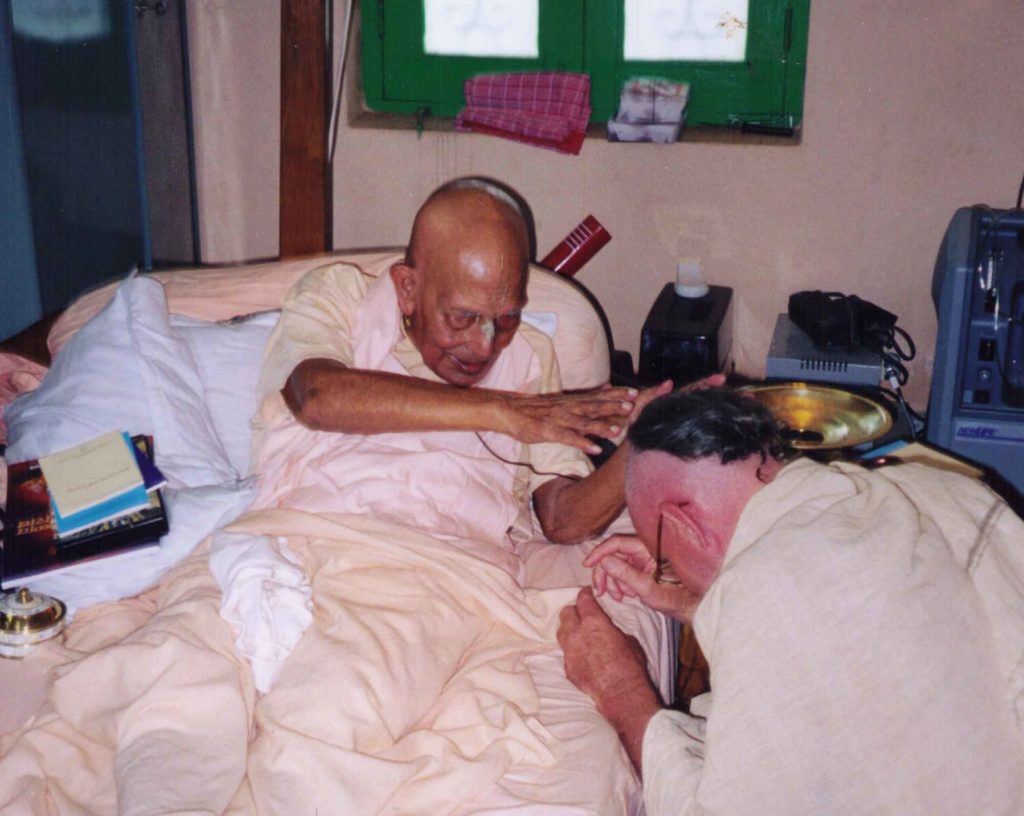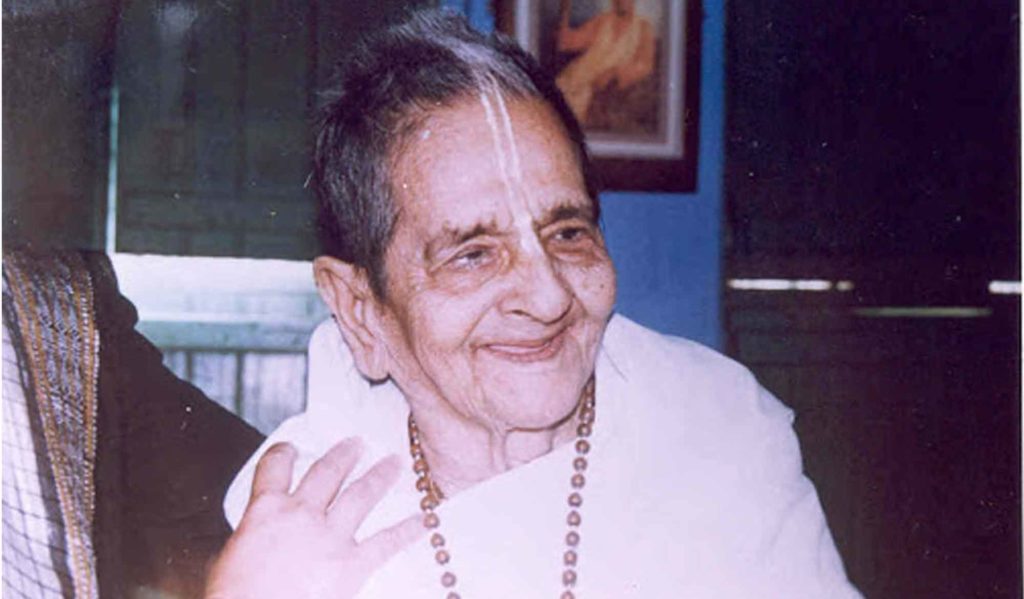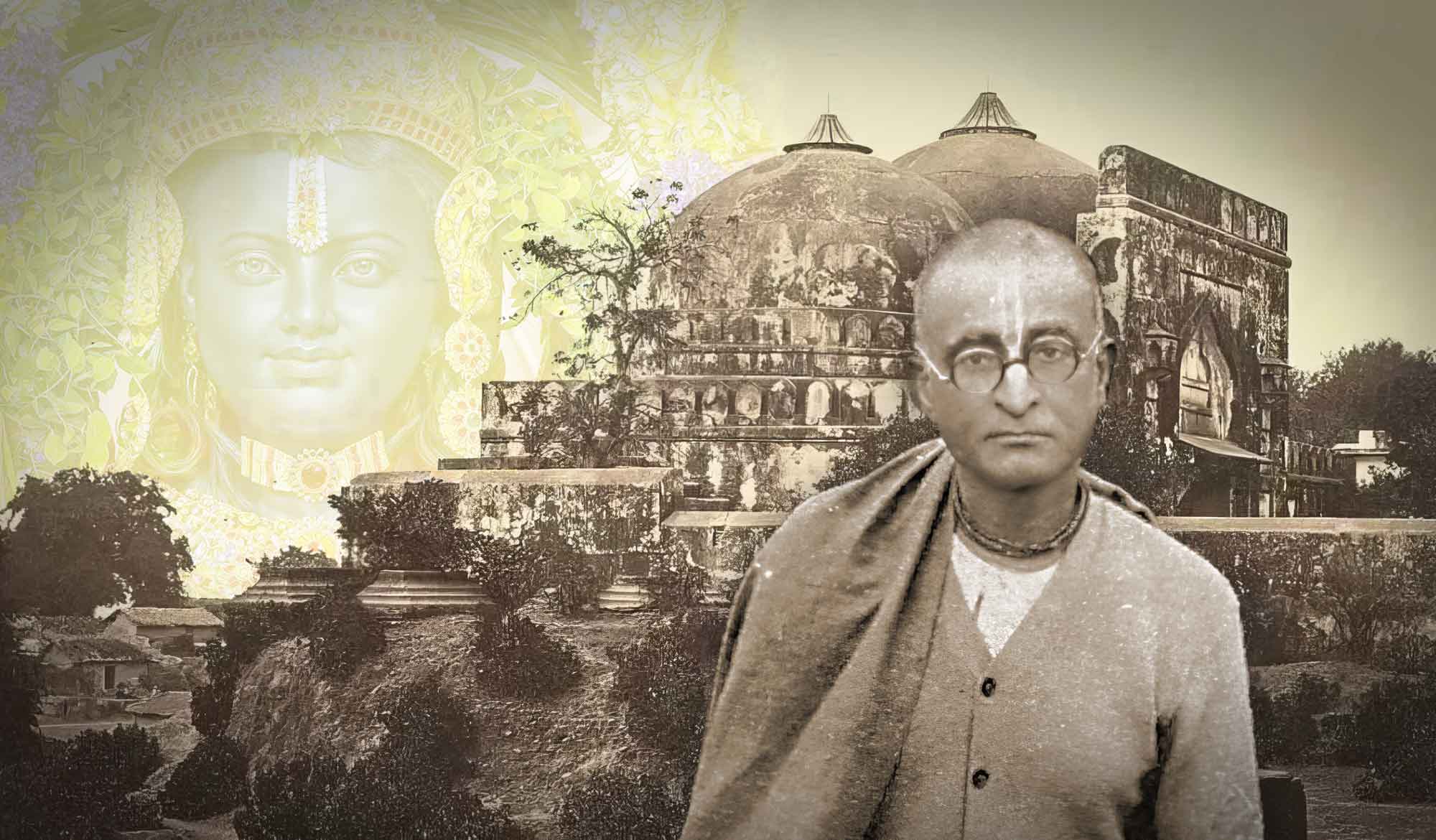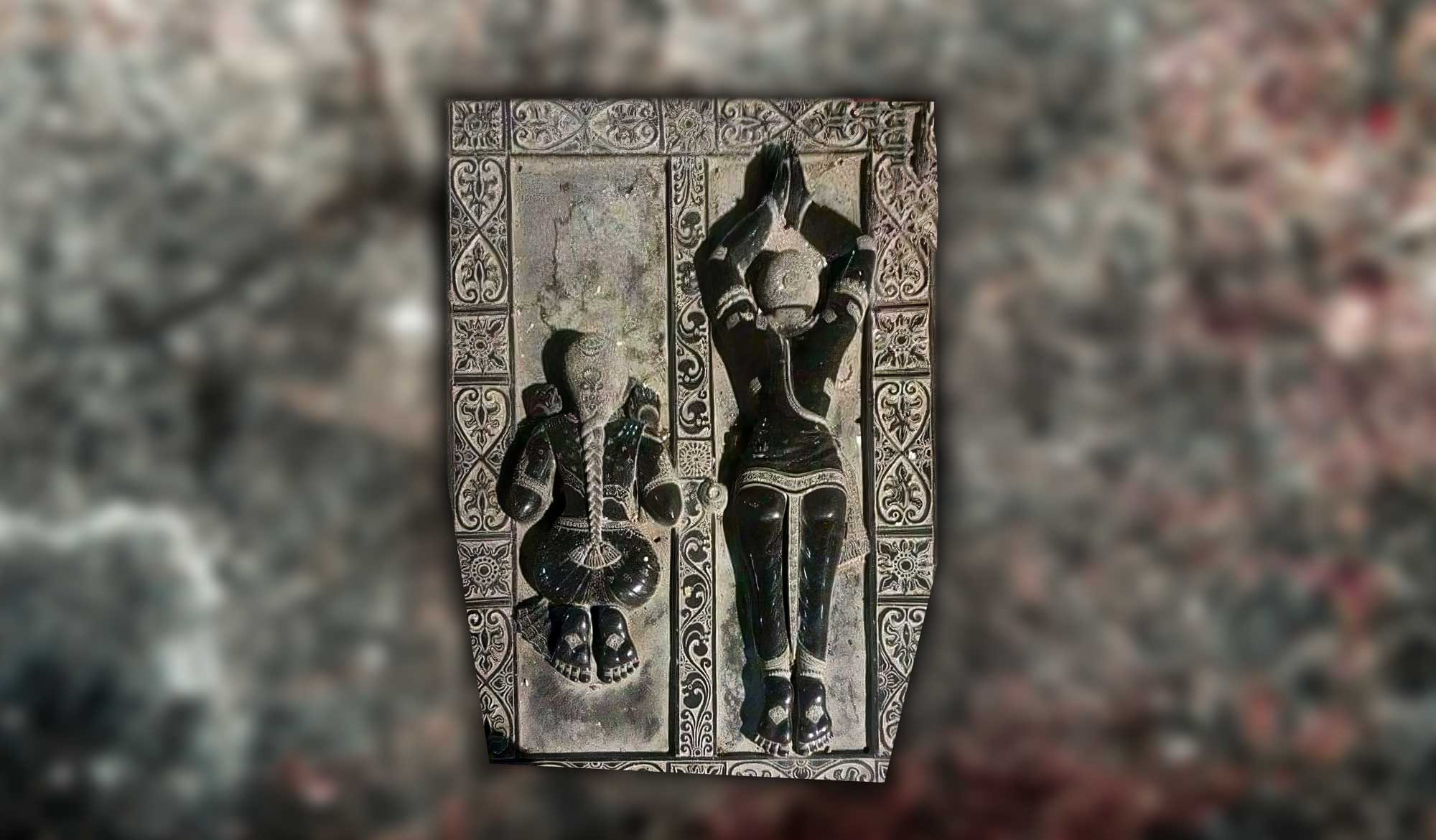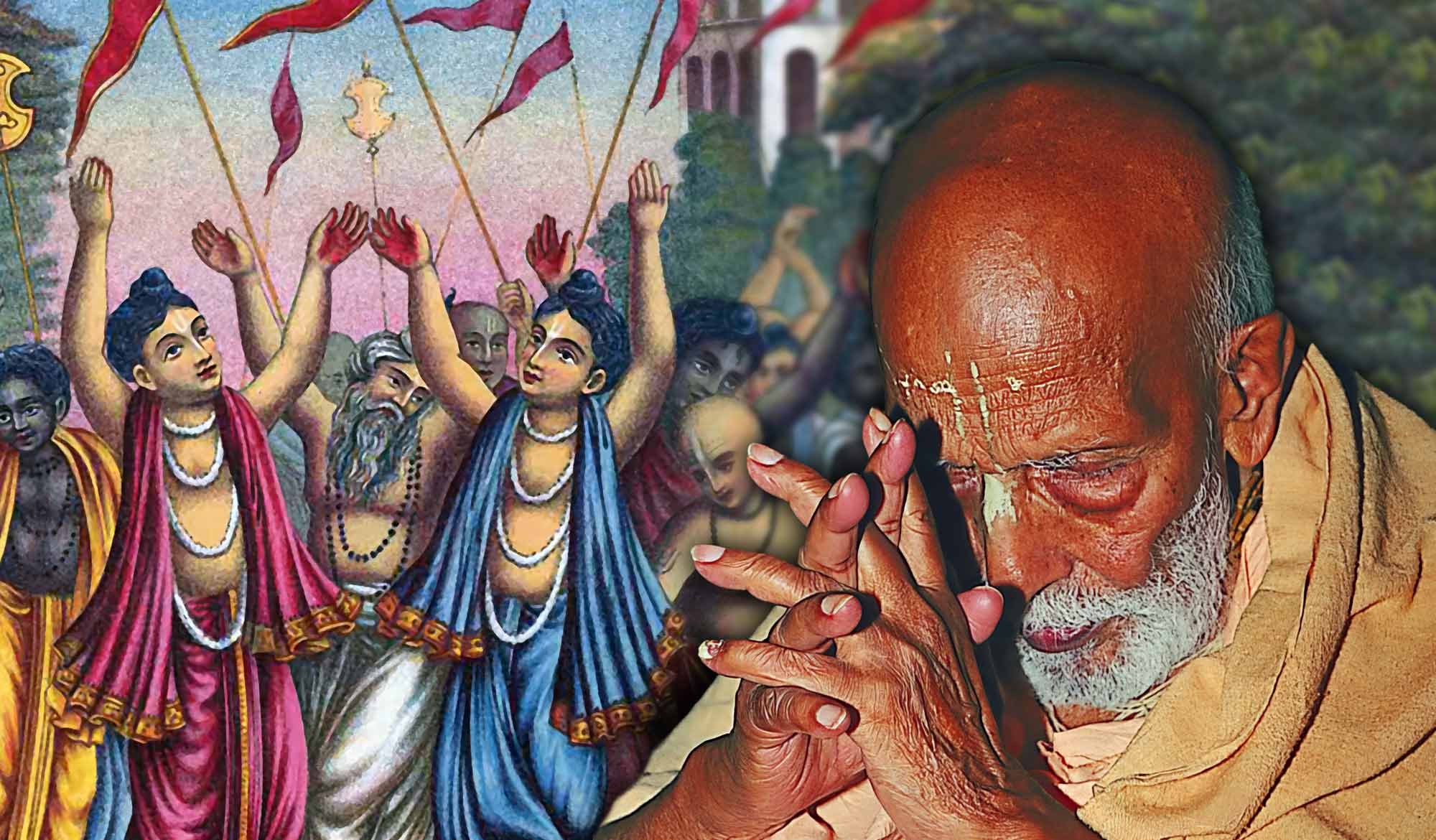Overview
In 'A Few Words on the Rasa of Śrīla Prabhupāda and the 'Suicide Squad' Śrīla Narasiṅgha Mahārāja addresses the controversy surrounding the rasa of A.C. Bhaktivedānta Swami Prabhupāda and gives his opinion based on various references, but ultimately concludes that such high topics are not for ‘public ears’.
śrī rādhikā priyaṅkarī, śrī kārttikī-māsa bari
giri-rāja hṛdayete smari
tiṅho aprakaṭa hailā, nitya-līlā praveśilā
rāje yetā rādhā-saṅge hari
“Completing his missionary activities in the western world Śrīla Prabhupāda returned to Vṛndāvana. Accepting the month of Kārttika, which is non-different from Śrīmatī Rādhārāṇī, bearing Girirāja-Govardhana in mind and embracing the lotus feet of his most worshipful Lord in the core of his heart, Śrīla Prabhupāda made his disappearance from this world and entered the nitya-līlā, the eternal loving pastimes of Goloka where Lord Govinda is always effulgently present with His dearmost Śrīmatī Rādhārāṇī.”
ei panthā pradarśane, śikṣā dilā āmāgaṇe
kon vastu-siddhi lakṣya haiya
kari vāsa govardhane, dainya ātma-nivedane
labha śrī rādhikā-gaṇāśraya
“By showing us his disappearance from this world in the month of Kārttika and by revealing his desire to go to Govardhana Hill, Śrīla Prabhupāda has thus shown us the path which leads to the fulfilment of the ultimate aim and object of life, that is to obtain supreme shelter in the camp of Śrīmatī Rādhārāṇī’s associate-servants with humble self-surrender, residing always at Śrī Govardhana.” (Śrīla Prabhupāda Līlā-Smaraṇa-Maṅgala-Stotram 19-20)
Some devotees have misunderstood that I am definitively referring to Śrīla Prabhupāda in the last verse as being in mādhurya–rasa because of the words, labha śrī rādhikā-gaṇāśraya, to obtain supreme shelter in the camp of Śrīmati Radharani’s associate-servants. However, what is meant is that Śrīla Prabhupāda is a dear and affectionate servant amongst the associate servants of Śrī Rādhā, the Supreme Commander and Chief, who oversees all services to Lord Govinda, both in this life and the next. As Śrīla Prabhupāda has said:
“Guru is serving under his master and you all can do likewise. In nitya-līlā every devotee thinks like that, that my master is the most dear to Rādhā-Kṛṣṇa.” (Conversation with Hṛṣikeśānanda)
As regards opinions about Śrīla Prabhupāda’s rasa in Goloka, the most qualified person to speak about this in my opinion would be Prabhupāda himself:
“My Guru Mahārāja’s rasa is that of gopī, mañjarī, but I am in relationship with Kṛṣṇa as cowherd boy.” (Seattle, 1968 Conversation with Govinda Dāsī)
The following is confirmation by Śrīla Śrīdhara Mahārāja upon hearing our Guru Mahārāja’s poem, ‘Prayer to the Lotus Feet of Kṛṣṇa’:
“He has expressed himself, his eternal position, the acme of his aspiration. In Vṛndāvana he has established Balarāma and Kṛṣṇa and Nitāi-Gaura, and he is saying like that, Nitāi-Gaura are Kṛṣṇa and Balarāma. It is almost clear that he comes from that group. And now he is again there.”
Such a statement by Śrīla Śrīdhara Mahārāja is not to be taken lightly. Even so, a short time later some of Śrīla Prabhupāda’s disciples raised an objection to Śrīla Śrīdhara Mahārāja referring to Śrīla Prabhupāda as being in sakhya-rasa. Śrīla Śrīdhara Mahārāja was shocked by the immaturity of those devotees. The consideration of rasa was obviously not a topic that those disciples were familiar with. Indeed, their harshness in dealing with Śrīla Śrīdhara Mahārāja reflected their extreme neophyte state of Kṛṣṇa consciousness. At that time, Śrīla Śrīdhara Mahārāja said that because of the special empowerment of Śrī Niyananda Prabhu, our Guru Mahārāja may have couched his mādhurya tendencies in deference to Him.
I have written in the article “My Guru is Radharani” that Śrīla Prabhupāda was in mādhurya–rasa because he saw his guru as Śrīmati Radharani. Śrīla Śrīdhara Mahārāja confirms this as follows:
“Swami Mahārāja (our Prabhupāda) has clearly written that his guru is Rādhārāṇī. It is there — “Kṛṣṇa, Rādhārāṇī will be pleased if You help me in this campaign” — e-puṇya karibe yābe rādhārāṇī khuśi habe dhruva ati bali tomā tāi. So he has admitted that his guru is Rādhārāṇī. So we aspire after the service of Rādhārāṇī under the direction of Śrī Rūpa and other devotees, not committing any wrong.’
“In general rasa, general service of Kṛṣṇa, he preached in the West. Though he knew and admitted that, “My guru is Rādhārāṇī. Rādhārāṇī, my Gurudeva, has ordered me to preach in the west and Kṛṣṇa, my friend, You are to help me, because Rādhārāṇī will be satisfied, my Gurudeva. Your bigness is also like that. So, You must come to help me.””
For some devotees, Śrīla Prabhupāda is seen as being in mādhurya–rasa, for others as being in sakhya–rasa, some even claim to know his name and svarūpa, and yet for others ‘the jury is still out.’ In any case, His Divine Grace seems to have been of a class of devotees that Śrīla Śrīdhara Mahārāja sometimes called the ‘suicidal squad’.
“The highest is, wherever You are pleased to put me, I am satisfied with that. That is the highest. But conditional devotion must keep on your side. That is some conditional that is of a little lower order. Sālokya, sārūpya, sāmīpya, sārṣṭi – some sort of desire, self-pushing. Pushing the self towards Him, selfishness. “I am under Your full control. Whatever You want to do it will satisfy me. If You want to throw me down to the Hell – yes, do that! I am ready. By Your order I can do anything. Make or marr — mārobi rakhobi yo icchā tohāra. You have every right over me.” Such quality devotion and dedication is necessary.’
“Actually, such kinds of devotee – they are of the first rank. The ‘suicidal army’ – ‘suicidal squad.” (meeting with Tamāla-Kṛṣṇa Gosvāmī and Satvarūpa Gosvāmī in Navadvīpa, March 7, 1981)
A possible solution to the question of Śrīla Prabhupāda’s rasa may be found in Jaiva Dharma, chapter 21 wherein Vijaya-kumāra sees his guru, Raghunātha Dāsa Bābājī, as a manifestation of Lalitā Devī in mādhurya–rasa, whereas Vrajanātha sees Raghunātha Dāsa Bābājī as a manifestation of Subala in sakhya–rasa. Both devotees saw their guru in relationship to their own rasa with Kṛṣṇa.
“Vrajanātha was inspired upon seeing the good fortune of Vijaya-Kumāra and Raghunātha Dāsa Bābājī’s demonstration of compassion, so he said to Raghunātha Dāsa Bābājī, “Mahārāja, whenever I meditate upon the pastimes of Kṛṣṇa, an urge to serve Kṛṣṇa under the guidance of Subala strongly compels me.”’
“Raghunātha Dāsa Bābājī said, “What devotional service attracts you most?”’
“Vrajanātha replied, “Together with Subala, I imagine myself to be running after the straying calves of Kṛṣṇa’s herd and bringing them back to the fold. Kṛṣṇa sits there playing his flute, and Subala, sitting next to Kṛṣṇa, then asks me to take the calves for feed and water and afterwards bring them back to Kṛṣṇa.”’
“Raghunātha Dāsa Bābājī said, “I bless you to serve Kṛṣṇa under the direction of Subala. You are eligible for sakhya–rasa.”’
“Then a miracle happened, from that moment on Vijaya’s heart throbbed with anticipation, waiting for the slightest indication to perform any service for Lalitā Devī. He saw Raghunātha Dāsa Bābājī with a new understanding — as a manifestation of Lalitā Devī in person….”’
“On the other hand, Vrajanātha saw his guru, Raghunātha Dāsa Bābājī, from that moment on as a manifestation of Subala.””
(Jaiva Dharma of Bhaktivinoda Ṭhākura, Ch-21, Translation by Śrīman Sarvabhāvana Dāsa)
So what is Śrīla Prabhupāda’s eternal rasa in Goloka? Some may know, some may not know, but in any case what should be my requirement/qualification as a disciple of His Divine Grace? To answer my own question, in a word, I would say, “Selflessness” and I repeat these words of Śrīla Śrīdhara Mahārāja as my prayer at the lotus feet of our Divine Master:
“I am under Your full control. Whatever You want to do it will satisfy me. If You want to throw me down to the Hell – yes, do that! I am ready. By Your order I can do anything. Make or marr — mārobi rakhobi yo icchā tohāra. You have every right over me.”
When the disciple is qualified, the guru will appear and all that is knowable will automatically be known to the disciple.
yasya deve parā bhaktir yathā deve tathā gurau
tasyaite kathitā hy arthāḥ prakāśante mahātmanaḥ
“Only unto those great souls who have implicit faith in both the Lord and the spiritual master are all the imports of Vedic knowledge automatically revealed.” (Śvetāśvatara Upaniṣad 6.23)
To have realised the eternal rasa and status of one’s guru, or one’s own eternal rasa with Kṛṣṇa, is certainly an exalted state of Kṛṣṇa consciousness, and with certainty one can say that such realizations are an intimate part of one’s bhajana. According to the core Gauḍīya Vaiṣṇava scriptures composed by Sanātana Gosvāmī, Jīva Gosvāmī and Narrottama Dāsa Ṭhākura, such intimacies are better kept secret — not to be told here and there for the public ears, and certainly not to be forced upon others.
gopayed devatām iṣṭāṁ gopayed gurum ātmanaḥ
gopayec ca nijaṁ mantra gopayen nija-mālikām
“One should hide one’s worshippable Deity, one should hide one’s guru, one should hide one’s mantra, and one should hide one’s japa–mālā.” (Sanātana Gosvāmī, Hari-bhakti-vilāsa 2.147)
atra ca śrī-guroḥ śrī-bhagavato vā prasāda-labdhaṁ sādhana-sādhya-gataṁ sīéya-sarvasva-bhūtaṁ yat kim api rahasyaṁ, tat tu na kasmaicit prakāśanīyam
“Whatever confidential experiences are obtained in connection with ones sādhana and the goal awarded by the mercy of Śrī Guru or the Lord, that is one’s own wealth and should not be revealed to anyone.” (Jīva Gosvāmī, Bhakti Sandarbha 339)
āpana bhajana kathā, nā kahibo yathā tathā
ihāte haiba sāvadhāna
“I will be careful not to reveal my own bhajana here and there.” (Narottama Dāsa Ṭhākura, Prema-bhakti-candrikā 119)
Related Articles
- 📖 Prabhupāda Vijaya (Book)
- My Guru is Rādhārāṇī by Śrīla Bhakti Gaurava Narasiṅgha Mahārāja
- Become Guru! by Śrīla Bhakti Gaurava Narasiṅgha Mahārāja
- Purport to Śrīla Prabhupāda-līlā Smaraṇa-Maṅgala Stotram by Śrīla Bhakti Gaurava Narasiṅgha Mahārāja
- Mahāprabhu as Prabhupāda by Śrīla Bhakti Gaurava Narasiṅgha Mahārāja
- How Great is Śrīla Prabhupāda? by Śrīla Bhakti Gaurava Narasiṅgha Mahārāja
- A Few Words on the Rasa of Śrīla Prabhupāda and the ‘Suicide Squad’ by Śrīla Bhakti Gaurava Narasiṅgha Mahārāja
- The Prākṛta and Aprākṛta-līlā of Śrī Guru by Śrīla Bhakti Gaurava Narasiṅgha Mahārāja
- The Golden Age of the Saṅkīrtana Movement by Śrīla Bhakti Gaurava Narasiṅgha Mahārāja
- Bhaktivedānta by Śrīla Bhakti Gaurava Narasiṅgha Mahārāja
- The Disappearance of a Śaktyāveśa-avatāra by Śrīla Bhakti Gaurava Narasiṅgha Mahārāja
- Śrīla Prabhupāda – A Second Generation Devotee’s Perspective by Gaura Gopāla Dāsa
Prabhupāda Śrīla Sarasvatī Ṭhākura’s Visit to Ayodhyā
With the forthcoming observance of Śrī Rāma Navamī, we present 'Prabhupāda Śrīla Sarasvatī Ṭhākura’s Visit to Ayodhyā' written by Śrīla Bhaktisiddhānta Sarasvatī Ṭhākura Prabhupāda from The Gaudīyā magazine, Vol 3. Issue 21/ In December 1924, after visiting Benares and Prāyāga, Sarasvatī Ṭhākura visited the birth-site of Śrī Rāmācandra in Ayodhyā.
Śaraṇāgati – The Only Path to Auspiciousness
In this article, 'Śaraṇāgati - The Only Path to Auspiciousness', Dhīra Lalitā Dāsī analyses the process of śaraṇāgati (surrender) beginning with śraddhā (faith). She also discusses the role of śāstra and the Vaiṣṇava in connection with surrender.
Ātma Samīkṣā – The Value of Introspection
In this article, "Ātma Samīkṣā – The Value of Introspection" Kalki Dāsa highlights the importance of introspection in the life of a devotee and especially in relation to the worldly environment that surrounds us. He also explains how transcendental sound influences our capacity to introspect.
Svasti No Gaura-vidhur Dadhātu (May the Moon-like Gaura Bestow Auspiciousness)
This Bengali poem, ‘Svasti No Gaura-vidhur Dadhātu,’ (May the Moon-like Gaura Bestow Auspiciousness) written by Śrīla Bhakti Pramoda Purī Gosvāmī, was first published in 1965 in Caitanya Vāṇī magazine, Vol.5, Issue 1. In this composition, Śrīla Purī Mahārāja gives advice to the fallen jīvas to sincerely accept Mahāprabhu's gift of the Holy Name. This poem was translated into English by Sanātana Dāsa and Parameśvarī Devī Dāsī.
Prabhupāda Śrīla Sarasvatī Ṭhākura’s Visit to Ayodhyā
With the forthcoming observance of Śrī Rāma Navamī, we present 'Prabhupāda Śrīla Sarasvatī Ṭhākura’s Visit to Ayodhyā' written by Śrīla Bhaktisiddhānta Sarasvatī Ṭhākura Prabhupāda from The Gaudīyā magazine, Vol 3. Issue 21/ In December 1924, after visiting Benares and Prāyāga, Sarasvatī Ṭhākura visited the birth-site of Śrī Rāmācandra in Ayodhyā.
Śaraṇāgati – The Only Path to Auspiciousness
In this article, 'Śaraṇāgati - The Only Path to Auspiciousness', Dhīra Lalitā Dāsī analyses the process of śaraṇāgati (surrender) beginning with śraddhā (faith). She also discusses the role of śāstra and the Vaiṣṇava in connection with surrender.
Ātma Samīkṣā – The Value of Introspection
In this article, "Ātma Samīkṣā – The Value of Introspection" Kalki Dāsa highlights the importance of introspection in the life of a devotee and especially in relation to the worldly environment that surrounds us. He also explains how transcendental sound influences our capacity to introspect.
Svasti No Gaura-vidhur Dadhātu (May the Moon-like Gaura Bestow Auspiciousness)
This Bengali poem, ‘Svasti No Gaura-vidhur Dadhātu,’ (May the Moon-like Gaura Bestow Auspiciousness) written by Śrīla Bhakti Pramoda Purī Gosvāmī, was first published in 1965 in Caitanya Vāṇī magazine, Vol.5, Issue 1. In this composition, Śrīla Purī Mahārāja gives advice to the fallen jīvas to sincerely accept Mahāprabhu's gift of the Holy Name. This poem was translated into English by Sanātana Dāsa and Parameśvarī Devī Dāsī.



